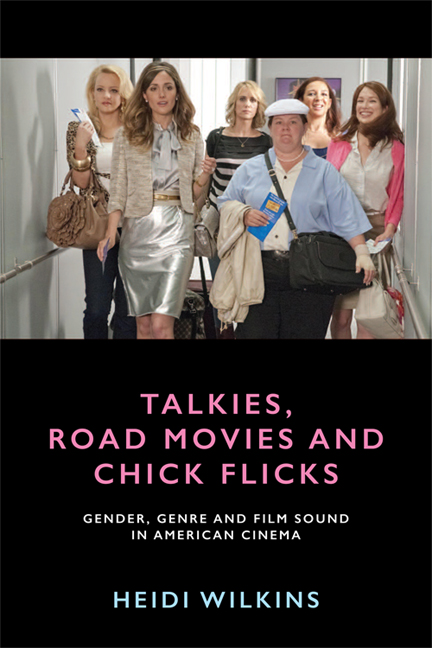Book contents
- Frontmatter
- Contents
- Acknowledgements
- Introduction
- 1 Talking Back: Voice in Screwball Comedy
- 2 All That Jazz: The Diegetic Soundtrack in Melodrama
- 3 The Alienated Male: Silence and the Soundtrack in New Hollywood
- 4 Brothers in Arms: Masculinity and the Vietnam War Movie
- 5 Subversive Sound: Gender, Technology and the Science Fiction Blockbuster
- 6 Girl Talk: The Postmodern Female Voice in Chick Flicks
- Conclusion
- Bibliography
- Filmography and Other Sources
- Index
2 - All That Jazz: The Diegetic Soundtrack in Melodrama
Published online by Cambridge University Press: 05 August 2016
- Frontmatter
- Contents
- Acknowledgements
- Introduction
- 1 Talking Back: Voice in Screwball Comedy
- 2 All That Jazz: The Diegetic Soundtrack in Melodrama
- 3 The Alienated Male: Silence and the Soundtrack in New Hollywood
- 4 Brothers in Arms: Masculinity and the Vietnam War Movie
- 5 Subversive Sound: Gender, Technology and the Science Fiction Blockbuster
- 6 Girl Talk: The Postmodern Female Voice in Chick Flicks
- Conclusion
- Bibliography
- Filmography and Other Sources
- Index
Summary
As modern film audiences, we are well aware of the capacity of music soundtracks to perform a multitude of functions in film. Music, whether diegetic (a part of the world of the film) or non-diegetic (outside of the world of the film), has the capacity to create emotion or humour; to be narrative or symbolic; to create atmosphere or provide information about a setting; and in its various forms, music is integral in creating meaning about film characters. This chapter looks at the use of music in melodramas of the 1940s and the 1950s. Melodrama is a film genre that notoriously makes use of music for its emotional capacity and for its ability to generate meaning about female protagonists in film texts that have been historically labelled as ‘women's films’ or ‘female weepies’. Thomas Elsaesser defines melodrama as ‘a dramatic narrative in which musical accompaniment marks the emotional effects’ and notably, the word melodrama itself is derived from the Greek word ‘melos’ meaning music, and the French word ‘drame’ meaning drama or performance. Kathryn Kalinak characterises the function of film music by ‘its power to define meaning and to express emotion’. Schatz notes that ‘Hollywood's use of background music to provide a formal aural dimension and an emotional punctuation to its dramas extends back even into the “silent” era’. In his historical study of film music, Mervyn Cooke observes that much musical film scoring was influenced by melodramatic theatrical traditions, which throughout the nineteenth century had developed a set of musical codes and conventions for symbolising emotion. He quotes Shapiro's 1984 study that highlights ‘the well-established symbiosis between music and drama that had in the nineteenth century shaped the development of major theatrical genres such as opera, ballet and (above all) melodrama’. Subsequently, when melodrama was integrated into film, this occurred with a series of musical conventions already in place and which were understood by audiences, particularly where non-diegetic music was concerned.
- Type
- Chapter
- Information
- Talkies, Road Movies and Chick FlicksGender, Genre and Film Sound in American Cinema, pp. 44 - 75Publisher: Edinburgh University PressPrint publication year: 2016



